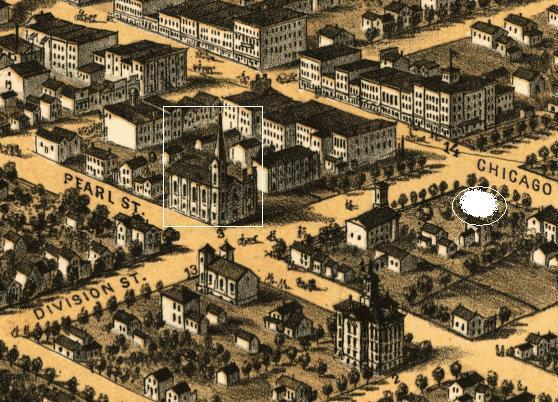Pastor Rob Patterson 653 A Street Galt, California 209-745-4665
go
to:
free
music
at
www.pastorob.com/audiodwnload.htm
go
to:
pastorob
at
www.pastorob.com/robísblog.htm
Nearly seventy-five years before I was born (1883) this drawing of my hometown
(Coldwater, Michigan) was published. The rectangle frames the church building
where my mother, Freida M. Patterson, served as a
Sunday School Director of the
First Baptist Church. Our entire family attended there until her death in 1962.
Connection with members of our church family was sporadic during the years that followed.
The white oval area on Chicago Street is where the Coldwater Public Library was built. I spent
many days in that library throughout my childhood, school years, and
most
recently during the month of my Sabbatical study in Coldwater.
Click here for a zoomable, complete panoramic view of Coldwater in
1883
In 1834 the "old red
schoolhouse" was erected at the corner of Pearl and Hudson Streets.
In 1835 Masonville was
platted on the east bank of the Coldwater River and again struggled to become
the county seat. That year the Baptist Church was organized with sixteen
members.
In 1836 the first church
was built in Coldwater by the Methodists. The village had twelve houses and
continued to grow. The next year Coldwater was incorporated as a village having
a population of 140 people. Dr. Alger, traveling the Chicago Road from Detroit
to Chicago, found at this time 32 taverns between Quincy and Sturgis, indicating
the tremendous westward immigration through here at this time.
1837 was a terrible year
for malaria fever. 32 out of 140 people died that fall. The cause was said to be
the Clay Street Milldam and the angry citizens, taking the law into their own
hands, destroyed it. Also this year the first newspaper, The Observer, was
issued and the Presbyterian Church organized with sixteen members.
In 1840 the Pottawatomi
Indians, except for a few stragglers, were removed to the far west. This opened
for settlement much of the land of Branch County, which had been designated as
Indian Reservations. It also helped bring in many new settlers who had been
deterred by the presence of such a large Indian population in the County. To
this date progress has been steady.
In 1841 Albert Chandler
founded the Coldwater Sentinel and in 1842 Coldwater became the permanent County
Seat, supplanting the village of Branch and blasting Masonville's hopes.
In 1844 two churches were
built; the Baptist Church was built on the northwest corner of Monroe and Pearl
Streets, and the Presbyterian Church was built on the present site of the new
building today, but was sold in 1868 to the Lutherans who moved it to its
present location on S. Jefferson Street.
In 1846 the first jail was
erected. Also, the voters voted against the sale of liquor.
In 1847 the county voted
to build a brick courthouse by a majority vote of 27. A majority of 27 was the
same when the proposition to build the second one carried 40 years later. This
one burned down on December 5, 1972, and another new courthouse started
construction in the fall of 1974 on the same spot. Also this year, the Masonic
Lodge was established.
In 1849 the telegraph
lines reached Coldwater and St. Charles Catholic Church was formed.
1850 was a banner year for
the growing village. The first train arrived and Coldwater was connected
directly to the populous East.
For many years Coldwater
and Branch County were noted for their horses. The start was made in 1851 when
A.C. Fiske purchased Green Mountain Black Hawk for the enormous price of $1,500.
Many people now living can remember the various racetracks in and around
Coldwater. Raising and training racehorses was a big industry for many years. In
1851 Coldwater boasted 370 houses, but the first of many disastrous fires
destroyed eight stores in the business section during the winter.
In 1854 another disastrous
fire along Main Street caused the village board to prohibit the erection of any
frame buildings from Clay Street to the parks. This was the first zoning acted
upon in the community. The Main Street because of this action was built of
brick. Also this year, Oak Grove Cemetery was established, which continued to
expand. There had been two earlier cemeteries, one at Masonville, which today is
a cultivated field; the other on Morse Street which contains tombstones
recording burials from 1835-1857. The present cemetery board maintains this
burial ground even though there have been no burials since 1857.
In 1856, because of the
many fires, the first fire company was organized with Clinton B. Flask as
foreman. Everyone was proud of the "Excelsior" the hand-pump that was purchased.
In 1857 the corner stone
of the Episcopal Church was laid. This building was completed in 1862.
In 1861 Coldwater became
an incorporated city. That year The Coldwater Light Artillery (later called
Loomis Battery) left for the war with six brass cannons and 120 men, only 49 of
whom returned home three years later. Coldwater, even as her men have done in
the years since, paid for her existence with the blood of her youth. Many other
Coldwater men enlisted in the 1st Michigan Infantry and the list of casualties
was large for such a small town. It is said that over 500 men from Coldwater
fought in the Civil War. To show how the raising of horses had grown in the
county during the war years of 1861-65, over 3,000 horses were brought here for
use in the Federal Service.
Pastor Rob Patterson 653 A Street Galt, California 209-745-4665
go
to:
free
music
at
www.pastorob.com/audiodwnload.htm
go
to:
pastorob
at
www.pastorob.com/robísblog.htm
